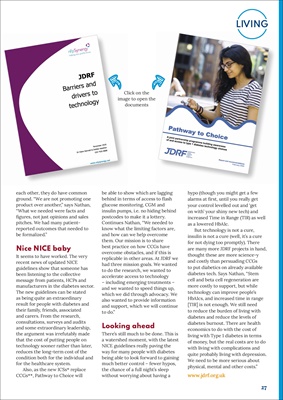
27
LIVING
each other, they do have common
ground. "We are not promoting one
product over another," says Nathan,
"What we needed were facts and
figures, not just opinions and sales
pitches. We had many patientreported
outcomes that needed to
be formalized."
Nice NICE baby
It seems to have worked. The very
recent news of updated NICE
guidelines show that someone has
been listening to the collective
message from patients, HCPs and
manufacturers in the diabetes sector.
The new guidelines can be stated
as being quite an extraordinary
result for people with diabetes and
their family, friends, associated
and carers. From the research,
consultations, surveys and audits
and some extraordinary leadership,
the argument was irrefutably made
that the cost of putting people on
technology sooner rather than later,
reduces the long-term cost of the
condition both for the individual and
for the healthcare system.
Also, as the new ICSs* replace
CCGs**, Pathway to Choice will
be able to show which are lagging
behind in terms of access to flash
glucose monitoring, CGM and
insulin pumps, i.e. no hiding behind
postcodes to make it a lottery.
Continues Nathan, "We needed to
know what the limiting factors are,
and how can we help overcome
them. Our mission is to share
best practice on how CCGs have
overcome obstacles, and if this is
replicable in other areas. At JDRF we
had three mission goals. We wanted
to do the research, we wanted to
accelerate access to technology
- including emerging treatments -
and we wanted to speed things up,
which we did through advocacy. We
also wanted to provide information
and support, which we will continue
to do."
Looking ahead
There's still much to be done. This is
a watershed moment, with the latest
NICE guidelines really paving the
way for many people with diabetes
being able to look forward to gaining
much better control - fewer hypos,
the chance of a full night's sleep
without worrying about having a
hypo (though you might get a few
alarms at first, until you really get
your control levelled out and 'get
on with' your shiny new tech) and
increased Time in Range (TIR) as well
as a lowered HbA1c.
But technology is not a cure,
insulin is not a cure (well, it's a cure
for not dying too promptly). There
are many more JDRF projects in hand,
thought these are more science-y
and costly than persuading CCGs
to put diabetics on already available
diabetes tech. Says Nathan, "Stem
cell and beta cell regeneration are
more costly to support, but while
technology can improve people's
HbA1cs, and increased time in range
[TIR] is not enough. We still need
to reduce the burden of living with
diabetes and reduce the levels of
diabetes burnout. There are health
economics to do with the cost of
living with Type 1 diabetes in terms
of money, but the real costs are to do
with living with complications and
quite probably living with depression.
We need to be more serious about
physical, mental and other costs."
www.jdrf.org.uk
Click on the
image to open the
documents